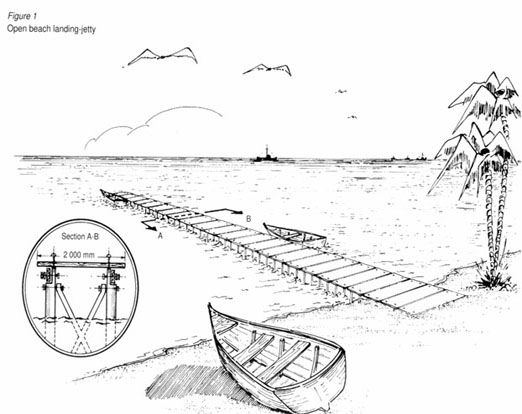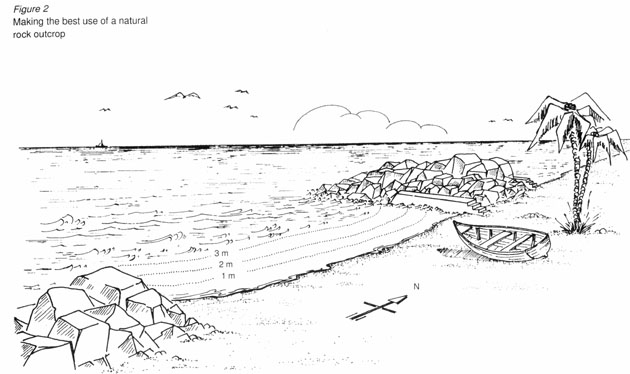An ideal site should basically offer the following:
- Total or partial protection from prevailing sea storms;
- Water depth in the range 1.50 - 3.0 m within easy access from the shoreline;
- Good access from the land side for either pedestrian or car traffic.
Preferably, the site should also offer the following:
- A small tide-level variation;
- Good beaching facilities in the vicinity(sandy beach);
- Absence of seaweed.
However, an ideal site, such as a protected sandy inlet, does not always coincide with the wishes of the local fishermen.
Often the ideal site for a shelter does not lie within a
reasonable walking distance from the village. In such cases, the
best use has to be made of the environmental conditions closer to
home.
When examining a site, the first three conditions usually decide
the eventual cost of the shelter. If the site is not protected
against the prevailing storms, more money will have to go into
protecting the shelter by building a bigger and stronger
breakwater. On the other hand, if the site is well protected, a
smaller, cheaper finger-jetty landing may be more suitable. If
the water is too deep, all the structures will have to be bigger
and hence more costly. If the area is too shallow, on the other
hand, routine dredging will be needed to keep the shelter open
for passage.
Needless to say, the area must also be accessible from the shore-side. Sometimes a footpath may suffice, but more usually some sort of road access is necessary for light trucks in both wet and dry seasons.
No two locations are identical. The following are just a few simplified examples which should be used only as a guide to selecting an appropriate site for a landing-quay or -jetty.
A long open beach (at least 1 km long) facing the ocean
(Figure 1) is typical of many fishing communities . Here the only
suitable landing is a beach landing, or, if the incident waves
are not too large, a simple jetty on piles placed anywhere along
the beach clos to the village.
The most important thing to observe is the area where incoming
waves break. The jetty should reach beyond this area so that
waves do not break against it and damage the boats tied up to it.
If the waves are big, say over 2 m high, the jetty has to be very
strong to resist the wave action. No attempt should be made to
build anything solid (such as a breakwater) on a sandy beach.
This interfere with the free movement of sand and may even lead
to the beach disappearing over a few years. If a breakwater is
considered necessary, then expert advice should be sought prior
to construction.
Figure 2 shows a small sandy bay flanked by two headlands. These heads of rock provide both a good foundation on which to build a small quay without the risk of damage to the beach. A rock outcrop also provides shelter against the prevailing wave direction. Two quays, one on either side of the outcrop, would provide an all weather-facility, with either the north side or the south side in use, depending on the prevailing wave conditions. Any solid structure sticking out on to the sandy beach should be avoided.


Offshore reefs are a very common feature along some coastlines and on coral islands. As a general rule, a stone breakwater should not be built on the reef where big incoming waves may wash it away (Figures 3a and 3b). As well as demolishing the breakwater, the waves would also dump the stones over a wide area turning them into a hazard to navigation.
A stone breakwater should be built inshore of the reef (Figure
3d) where the reef itself protects the breakwater. If the area
inshore of the reef does not allow a safety margin of about 30 -
50 m, a concrete wall anchored to the reef could be considered
(Figure 3c). If the reef consists of living coral, however, every
attempt should be made to preserve it in its natural state and to
find an alternative site elsewhere along the coastline. Living
coral is a primary source of the sand that makes up the
coastline. A dead coral-reef is of little use as a protection
because wave action will eventually break it all down into sand,
exposing the whole coastline to wave attack.
Live coral, on the other hand, constantly rebuilds itself.
Figure 4 shows the proper site for a landing on a meandering (curving) river. Rivers in general carry tonnes of silt and sand in suspension, especially during floods. This silt and sand is then deposited in places where the water-flow is slower than normal. When a river flows around a bend, the water on the outside. This causes the silt and sand to fall out of suspension and deposit themselves on the inner reaches of the bend in the river. On the opposite side, however, the higher speed of the water-flow constantly erodes the bank while preventing the silt from being deposited. Although the stronger current at the outer bank makes it more difficult to navigate, a landing built here may be cheaper to maintain because it will need less dredging than one built on the inner bank. Lower maintenance costs may mean the difference between a serviceable landing that is open all the year round, and one that has to close because the costs of dredging are too high.
River mouths usually offer good protection against bad weather. However, river mouths also tend to shift position, especially in low-lying areas where there are monsoons. In such cases, special care should be taken when deciding on the type of structure and its position in relation to the coastline. Along the coastline any kind of vegetation (especially mangroves) should be preserved because vegetation is the only natural means of controlling the shape of the coastline.
|
|
|
|---|